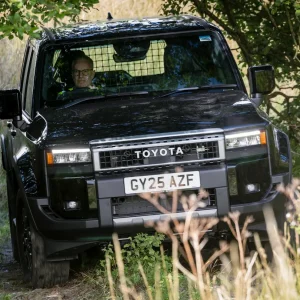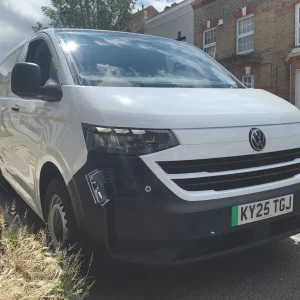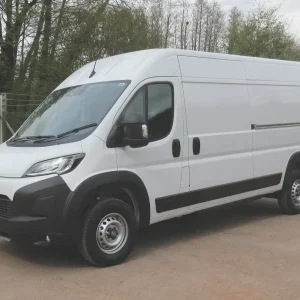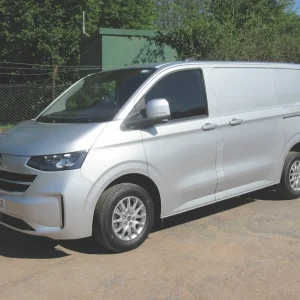On sale at the beginning of May, directly following the CV Show where it’s making its UK debut, the Bipper — and its siblings the Citroën Nemo and Fiat Fiorino — represents a new size sector in the market; for the want of something better we’ll call it a sub-compact. It’s overall length is 3,860mm, the maximum width is 1,680mm and the overall height is 1,721mm. Fit the optional roof bars and this increases to 1,780mm.
With a load capacity of 2.5m3 Bipper slots in below the current Partner (3.0m3) and despite its significantly smaller overall dimensions manages to match its gross payload at 610kg.
Engines
There are just the two engine options for the Bipper. The most significant is the impressive 1.4-litre HDi common rail turbodiesel unit also found under the bonnet of the 207; and for that matter is basically the same engine that’s used by Ford in the Fiesta Van.
It produces maximum power of 70hp at 4,000rpm and develops peak torque of 160Nm at 1,750rpm, the bulk of which is available up to 2,750rpm. For the record it has a CO2 exhaust emission figure of 119g/km which goes to show just how efficient this little powerplant really is.
The other is a 1.4-litre, petrol capable of 75hp, but a paltry 118Nm of peak torque at a rather high 2,600rpm. It is not known whether Peugeot will offer this engine in the UK, but if a customer wants one to convert to run on liquid petroleum gas there shouldn’t be a problem.
Bipper is front-wheel drive and comes with a five-speed manual transmission as standard, but there will be an optional five-speed automated manual ‘box available. It uses an electro-hydraulic control system and can be driven in either manual or automatic modes. In theory it should help to reduce wear and tear, fuel consumption and emissions.
Suspension
McPherson-type struts, coil springs and dampers take care of Bipper’s front end while torsion beam, springs and dampers control things at the back. The body is secured to the rear suspension assembly by means of flexible mountings which are designed to filter out road noise and vibrations.
Brakes are discs at the front and drums at the rear, and we are pleased to report that ABS is a standard item. ESP is not currently on the options list, but will be added at a later stage.
Hydraulic power steering comes as standard, there are 2.8 turns lock-to-lock and the Bipper has a pleasantly small turning circle of 10.2m between kerbs.
Load Area
 Despite its diminutive external dimensions Bipper is still able to supply a useable load length of 1,523mm, a maximum height of 1,178mm and a width of 1,473mm, narrowing to 1,046mm between the wheel boxes. Rear loading height is a more than acceptable 527mm
Despite its diminutive external dimensions Bipper is still able to supply a useable load length of 1,523mm, a maximum height of 1,178mm and a width of 1,473mm, narrowing to 1,046mm between the wheel boxes. Rear loading height is a more than acceptable 527mm
If the optional folding passenger seat is specified the load length is increased by close on a metre, effectively raising the load cube from 2.5m3 to 2.8m3.
The load area is accessed via twin asymmetric side-hinged rear doors — there is no top-hinged hatch option — and there’s the option of one or two sliding side doors for additional versatility. It has to be said, however, that the aperture provided by these doors is a rather odd shape and may not prove to be particularly useful for loading/unloading boxes, for example.
The rear doors open to 90°, extending to 180° if the door stays are released. Six load-tie rings are provided as standard.
As we have come to expect these days, the load doors can be locked/unlocked separately from those of the cab thanks to the three-button remote control.
In-Cab Storage
 There is no denying that the Bipper has been designed to be a working tool from the outset and this is ably confirmed by the sensible and practical amount of storage space provided in the surprisingly roomy cab. The only slight criticism is that the lid of the glovebox has a tendency to catch the passenger’s knees when dropped down.
There is no denying that the Bipper has been designed to be a working tool from the outset and this is ably confirmed by the sensible and practical amount of storage space provided in the surprisingly roomy cab. The only slight criticism is that the lid of the glovebox has a tendency to catch the passenger’s knees when dropped down.
The driver gets an air bag as standard, with one for the passenger likely to be an option in the UK. Driver and passenger side air bags will also feature on the options list.
On the Road
This — along with its cousins the Nemo and Fiorino — has to be one of the easiest vans to drive we have come across recently. The driving position is excellent, helped by the rake- and reach-adjustable steering column, and the dash-mounted gearstick is set at a nigh-on perfect height.
The seats are comfortable and supportive, but the jury is still out on the folding passenger seat option. It may be practical, but we are not convinced about its long-distance comfort quotient.
The little diesel is ideally suited to this vehicle and is a pleasure around town. Take it out on the motorway and it can comfortably sit at the legal speed limit. The steering provides plenty of feedback and if its manoeuvrability you’re after, look no further.
The handling is about as good as it gets for a small front-wheel drive van and the ride, while a bit fidgety unladen, settles down with a load on board.
Running costs shouldn’t be too wallet-destroying thanks to a quoted combined cycle consumption figure of 63mpg and an 18,500-mile or two-year service interval. Peugeot also points out that to further reduce costs the oil change and replacement of components such as the air, diesel and pollen filters, and the brake pads are scheduled to coincide with the service interval.
VERDICT
We have now driven all three of the Fiat/PSA sub-compact newcomers, albeit in left-hand drive, and if our most recent experience of the Bipper is anything to go by they are going to find friends pretty quickly in the UK; providing the price is right, of course. We await the announcement at the CV Show in April.

 It's going to be a busy year for Peugeot dealers when it comes to light commercials. They already have the new Boxer (launched 2006), Dispatch and 207 Van from last year and the all-new Partner going on sale this summer. But that's not the end of it. Factor the Bipper into the equation and they should be in for bumper LCV sales.
It's going to be a busy year for Peugeot dealers when it comes to light commercials. They already have the new Boxer (launched 2006), Dispatch and 207 Van from last year and the all-new Partner going on sale this summer. But that's not the end of it. Factor the Bipper into the equation and they should be in for bumper LCV sales.



